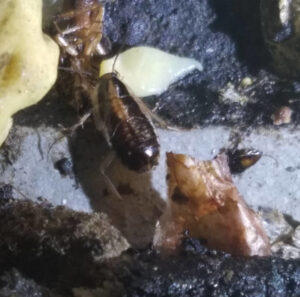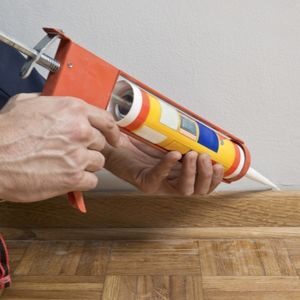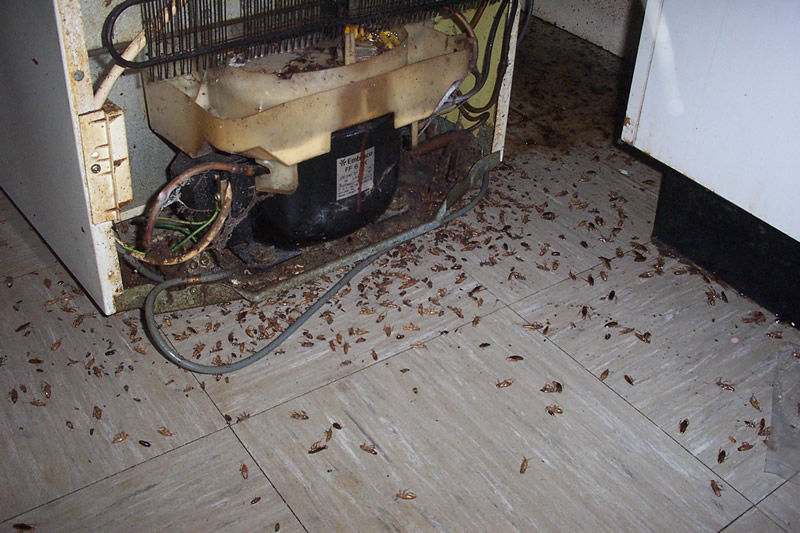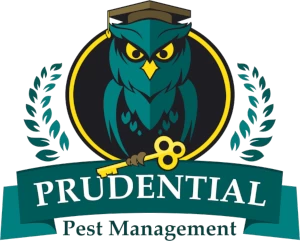Cockroach Control Treatment
Cockroach Control Treatment
 Prudential Pest Management provides a reliable cockroach control treatment to our customers. We send a technician to visit your property and conduct an exhaustive inspection of the premises.
Prudential Pest Management provides a reliable cockroach control treatment to our customers. We send a technician to visit your property and conduct an exhaustive inspection of the premises.
Our Technicians are trained to find the most common cockroach hiding spots and signs of cockroach activity. A Technician may also place sticky traps on the premises to allow for continuous monitoring, as cockroaches are nocturnal.
If cockroaches are present on your property, our Technician will identify the cockroach species and recommend the most appropriate treatment plan. Several factors will play into the treatment plan, including:
- Species of cockroach
- Type of property (for example – a commercial business that serves food versus a home)
- Type of environment
- The severity of the infestation
Depending on these factors, your cockroach treatment plan may include a variety of baiting and non-chemical solutions designed to eliminate infestations. After an initial treatment is applied, your Technician will schedule a follow-up service depending on the severity of the cockroach problem. Business owners and managers interested in the benefits of a long-term protection program and cost savings may be interested in a Packaged service.
Schedule our Cockroach Control Treatment (810)410-8563
How to Prevent Cockroaches
According to the CDC, “The cockroach is considered an allergen source and an asthma trigger….” This is why it is essential to prevent potential roach issues ahead of time. Besides hiring a professional roach exterminator, a few roach repellents and monitors may help prevent or catch problems early on. In addition to various do-it-yourself cockroach repellents, you can also take several practical steps to keep cockroaches out and prevent an infestation.
 Eliminate food sources – store dry foods in tightly sealed containers or plastic bags, and do not leave food sitting on counters. Do not leave liquids in sinks or buckets.
Eliminate food sources – store dry foods in tightly sealed containers or plastic bags, and do not leave food sitting on counters. Do not leave liquids in sinks or buckets.- Clear all waste food and liquid spillage – clean up food debris from food preparation areas, under sinks, and appliances. Empty the rubbish daily and keep all garbage or compost in sealed bins.
- Remove pet food – and drink, and litter trays before nightfall.
- Rinse cans, bottles, and plastics – before putting them in recycling bins.
- De-clutter – remove old stacks of newspapers and magazines, unused cardboard boxes, and all other clutter from the floor or bottom of cupboards. Cockroaches release an aggregation pheromone in their droppings, telling others they have found a safe harborage.
- Varnish or paint wood shelves – seal them and wipe them clean regularly.
- Seal entry points – to deny access to cockroaches. Key risks are gaps around pipes, drains, and common walls with neighboring properties when dealing with German, Oriental, and American cockroaches. Even tiny cracks around skirting boards and behind electrical sockets should be plugged in to reduce potential hiding areas.
Signs of a Cockroach Problem
There are some simple ways to identify a possible cockroach infestation that could require professional treatment.
- Cockroach droppings – cockroaches leave a dust of black droppings less than 1mm wide and varying lengths.
- Smear marks – check for spots on horizontal surfaces and at wall-floor junctions where cockroaches are active. If water is abundant, cockroaches produce brown and irregularly shaped smear marks.
- Shed skin – look for this evidence in locations you suspect they are sheltering. Cockroaches shed ‘cast nymphal ‘skins 5-8 times as they mature into adults.
- Damage – look for unusual signs of wear, not just on food packaging. Cockroaches will attack organic goods, including leather and books.
- Unusual odor – an established cockroach infestation produces a lingering and unpleasant musty smell that taints items they contact.
- Live cockroaches in your bathrooms and kitchens – German cockroaches need warmth and humidity and may be found around bathrooms, laundry rooms, and kitchen areas. They are also good climbers, efficiently scaling smooth surfaces like glass & polished metal due to the sticky pads on their feet. You might see them when turning on the light in the kitchen at night.
- Cockroaches in your basement – Oriental cockroaches can cope with colder, damp conditions and can be found in basements or drains. If conditions are tolerable, they can survive outside in areas such as landfills. Although not as agile as German cockroaches, they can climb a surface such as rough brickwork.

Cockroach Species
There are over 4,000 different types of cockroaches — some are considered pests, while others are beneficial in their natural environment. The three main types of cockroaches commonly found in homes in the US include the German cockroach, the Oriental cockroach, and the American. Find more detailed information below about these common species.
German Cockroach (Blatella germanica)
- Appearance – Notorious for their worldwide distribution, German cockroaches are easily identifiable by two dark longitudinal stripes on their pronotum. Adults grow to approximately 12 – 15mm in length.
- Lifecycle – Females carry 35 – 40 eggs in an ootheca (egg case) until they are ready to hatch—hatch in 1 month. Nymphs take between 6 weeks to 6 months to develop into adults. Generally, 3-4 generations per year.
- Habits – Most commonly found indoors. It prefers wet, humid conditions and is typically found in kitchens and bathrooms in homes and commercial properties.
Oriental Cockroach (Blatta orientalis)
- Appearance – Dark brown or black. 20 -25mm long. The wings are undeveloped in females and cover ¾ of the abdomen in males.
- Lifecycle – Females deposit 16 eggs in an ootheca (egg case). Hatch in 2 months. Nymphs take 6-18 months to develop into adults.
- Habits – Highly adapted for surviving in the natural environment, Oriental cockroaches thrive in cold, damp areas such as basements, drains, and openings beneath porches. Known for their preference for feeding on garbage and decay, these insects can most commonly be found in landfills and leaf litter. It runs rather than flies.
American Cockroach (Periplaneta americana)
- The American cockroach is one of the enormous pests cockroaches to invade homes and commercial properties.
- Appearance – 35 – 40mm long. They were shining red–brown. Wings are longer than the body in males; they only overlap the abdomen in females. Runs (may fly at very high temperatures).
- Lifecycle – The ootheca (egg case) containing up to 16 eggs is carried by the female for several days before being deposited. Sometimes cemented down and tended to be grouped. Hatch in 1 – 2 months. Nymphs usually develop in 6 -12 months, but it can take up to 15 months.
- Habits – Also known as the ‘Palmetto bug’ because they live on trees, the American cockroach prefers dark, humid, and undisturbed areas and can be found in sub-floors, basements, kitchens, roof voids, and bathrooms of homes.
Brown Banded Cockroach (Supella longipalpa)
- Appearance – One of the smallest pest cockroaches, brown-banded adult cockroaches are approximately 10 – 15mm long and characterized by yellow-brown stripes across their abdomen.
- Habits – Brown-banded cockroaches mostly stay on the ground but may fly in hot climates. Their preference for warm, humid environments leads them to harborages within heated buildings – ceilings, attics, and inside and around appliance motors. Primarily active at night, these opportunistic feeders enjoy highly starch materials.
Australian Cockroach – (Periplaneta australasiae)
- Lifecycle – Females deposit the ootheca (egg case) containing 24 eggs a day after production.
After hatching, nymphs take 6-12 months to develop into adults. - Habits – Enter buildings at night from gardens/debris. Generally prevalent in areas where winters are relatively mild. Despite its name, it isn’t a native species.
Smoky Brown Cockroach (Periplaneta fuliginosa)
- Appearance – 3-35 mm long. They were shining dark brown. Wings longer than the body in males; barely overlap abdomen in females. Runs (may fly at very high temperatures).
- Lifecycle – Females deposit the ootheca (egg case) containing 22-26 eggs a day after production. Nymphs take between 6-12 months to develop into adults. The noticeable difference between nymphs and adults, apart from the size, is the lack of wings in the young.
- Habits – Lives in tree hollows, under bark, under floors, and enters buildings at night.Nocturnal (hides during the day in cracks, crevices, or any other dark warm places). Has a habit of entering houses and contaminating food with excrement, regurgitated salivary fluid, and potentially harmful bacteria.
Our Cockroach Control Treatment is the solution to your cockroach problem! Contact Us Today!
Prudential Pest Management services the following areas in Michigan:
Genesee County, Tuscola County, Lapeer County, Oakland County, Livingston County, Shiawassee County, Saginaw County, Burton, Clio, Davison, Fenton, Flint, Flushing, Grand Blanc, Linden, Montrose, Mount Morris, Swartz Creek, Gaines, Goodrich, Lennon, Montrose, Otisville, Otter Lake, Clayton Township, Fenton Township, Flint Township, Flushing Township, Genesee Township, Grand Blanc Township, Montrose Township, Mount Morris Township, Mundy Township, Vienna Township, Argentine Township, Atlas Township, Davison Township, Gaines Township, Richfield Township, Thetford Township, and Forest Township. We service all communities in Genesse and its surrounding counties.
